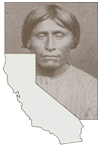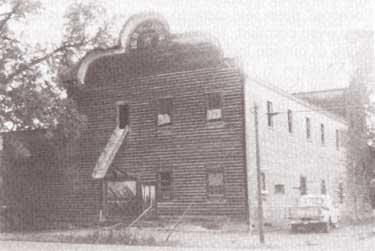![]()

Five Views: An Ethnic Historic Site Survey for California
MENU
Introduction
pre-1769
1769-1848
1849-1879
1880-1904
1905-1933
1934-1964
1965-1980
Historic Sites
Selected References

A History of American Indians in California:
HISTORIC SITES
Round Valley Flour Mill
Mendocino County
The Round Valley Flour Mill, constructed in the 1880s, stands alone on the northeast corner of a one-acre lot at the corner of Greeley and Main Streets in Covelo, California. Five walnut trees grow around the building on the southwest side of Mill Creek. The mill is approximately 40 feet wide and 70 feet long, three stories high, with weathered wooden shiplap siding and a corrugated metal gabled roof. A decorative false-front facade and rounded cornice dominate the eastern rectangular section of the mill, while a rusty, five-pointed star and the dates in raised wooden lettering "1888-1914" adorn the upper, rounded section of the facade, which was added in 1914. The ground floor has a large sliding door, a conventional front entry door, and two windows. The front of the flour mill has a chute that extends from the top floor to the first floor on the left side. Some of the mill's machinery dates to the 1880s and was operable as recently as 1975. To the north of the flour mill lot is a light commercial district, and to the south and west are residential neighborhoods. Today, the mill exists as an example of a steam-powered, steel-roller grain mill.
The flour mill at Round Valley is important because it provided work for Indians who had been relocated to the Covelo area in the 1850s and 1860s. The land on which the mill stands was once the territory of the Yuki Indians. They used about 1,100 square miles of this region, which ranged from 1,000 feet to 7,500 feet in elevation, for hunting, fishing, and gathering. To the north of the Yukis were the Wailaki; to the west, the Cahto; to the southeast, the Huchnom; to the southwest, the Pomo; and to the east, the Nomelaki. After 1860, many tribes were "driven" to Nome Cult Farm from their various homelands in Northern California. It was intended that they be segregated, and that White occupation of their traditional lands be accommodated. The word "drive," widely used at the time, is descriptive of the practice of "rounding up" Indians and "driving" them like cattle to reservations, where they were corraled. (Fredrickson, 1979:41) The first group of outside Indians to enter Round Valley were the Konkaws in 1856. Other groups arrived in 1863 including the Konkows and Maidus. The Pit Rivers were taken in 1861, the Little Lakes between 1865 and 1875, some of the Wailaki in 1861, some Nomelakis in 1863, and the Hat Creeks and some Wappos and Cahtos in 1862. The Yahi Yana from Mill Creek entered the reservation in 1863, and a group of Yankee Hills Pit Rivers arrived in 1864. The Huchnom from Redwood Valley were forced onto the reservation in 1869, and Pomo Indians from Mendocino and Lake counties arrived in 1874.
After considerable suffering from lack of traditional food, the Indian families residing at Round Valley received land allotments of various sizes under the Dawes Severalty Act of 1887. However, in 1934, the Indian Reorganization Act repealed the Dawes Act, and no Indian was allowed to buy or sell land, hold deeds, or handle cash. (Fredrickson, 1979:48) Because the government policy in Round Valley between 1887 and 1934 focused on agricultural and stock development, the flour mill provided valuable work and training for Indians in the area. It also served as a outlet for the Indians' milling of crops. The mill not only played a prominent role in the growth of local agriculture, but also helped reservation Indians acquire new skills at a time when they no longer had easy access to their traditional way of life.

Round Valley Flour Mill
NEXT> Santa Lucia Peak
Last Modified: Wed, Nov 17 2004 10:00:00 pm PDT
http://www.cr.nps.gov/history/online_books/5views/5views1h75.htm
![]()
 Top
Top